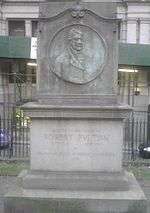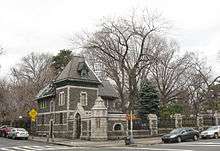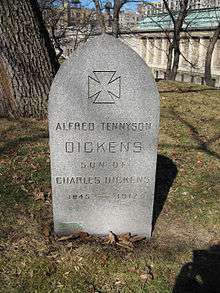Trinity Church Cemetery
|
Church of the Intercession and Trinity Church Cemetery | |
|
Trinity Church Cemetery at Broadway and Wall Street | |
 | |
| Location |
Trinity Church (shown): 74 Trinity Place Church of the Intercession: 550 West 155th Street St. Paul's Chapel: 209 Broadway, New York City, New York |
|---|---|
| Coordinates | 40°42′30″N 74°00′42″W / 40.70833°N 74.01167°WCoordinates: 40°42′30″N 74°00′42″W / 40.70833°N 74.01167°W |
| Built | 1697 |
| NRHP Reference # | 80002677 |

Trinity Church Cemetery consists of three separate burial grounds associated with Trinity Church in New York City, New York, US. The first was established in the Churchyard located at 74 Trinity Place at Wall Street and Broadway. In 1842, the church, running out of space in its churchyard, established Trinity Church Cemetery and Mausoleum in Upper Manhattan between Broadway and Riverside Drive, at the Chapel of the Intercession (now The Church of the Intercession, New York), formerly the location of John James Audubon's estate.[1] A third burial place is the Churchyard of St. Paul's Chapel.
A no longer extant Trinity Church Cemetery was the Old Saint John's Burying Ground for St. John's Chapel. It was in use from 1806–52 with over 10,000 burials, mostly poor and young. In 1897, it was turned into St. John's Park, with most of the burials left in place. The park was later renamed Hudson Park, and is now James J. Walker Park.[2]
The burial grounds have been the final resting place for many historic figures since the Churchyard cemetery opened in 1697. A non-denominational cemetery, it is listed in the United States National Register of Historic Places and is the only remaining active cemetery in Manhattan.[1][3] There are two bronze plaques at the Church of the Intercession cemetery commemorating the Battle of Fort Washington, which included some of the fiercest fighting of the Revolutionary War.
Trinity Church Cemetery, along with Broadway, marks the center of the Heritage Rose District of NYC.[4]
Notable burials
Trinity Churchyard
- William Alexander, Lord Stirling (1726–1783), Continental Army Major General during the American Revolution
- John Alsop (1724–1794), Continental Congress delegate
- William Bayard Jr. (1761–1826), banker
- William Berczy (1744–1813), Canadian painter
- William Bradford (1660–1752), colonial American printer
- Richard Churcher (1676–1681), a child whose grave is marked with the oldest carved gravestone in New York City
- Angelica Schuyler Church (1756–1814), daughter of Philip Schuyler, sister of Elizabeth Schuyler Hamilton
- Michael Cresap (1742–1775), frontiersman
- John R. Fellows (1832–1896), U.S. representative
- Robert Fulton (1765–1815), inventor
- Albert Gallatin (1761–1849), U.S. congressman, Secretary of the Treasury, founder of New York University
- Horatio Gates (1727–1806), Continental Army general during the American Revolution
- Aaron Hackley, Jr. (1783–1868), U.S. representative
- Alexander Hamilton (1755–1804), American revolutionary patriot and "founding father"; first U.S. Secretary of the Treasury
- Elizabeth Schuyler Hamilton (1757–1854), wife of Alexander Hamilton, co-founder and deputy director of New York's first private orphanage [5]
- Philip Hamilton (1783–1801), first son of Alexander Hamilton, grandson of U.S. General Philip Schuyler
- John Sloss Hobart (1738–1805), U.S. senator
- William Hogan (1792–1874), U.S. congressman
- James Lawrence (1781–1813), naval hero during the War of 1812
- Francis Lewis (1713–1802), signer of the Declaration of Independence
- Walter Livingston (1740–1797), delegate to the Continental Congress
- Luther Martin (1744–1826), delegate to the Continental Congress
- Charles McKnight (1750–1791), Continental Army surgeon
- John Jordan Morgan (1770–1849), U.S. representative
- Thomas Jackson Oakley (1783–1857), U.S. representative
- John Morin Scott (1730–1784), Continental Congress delegate, Revolutionary War general, first secretary of state of New York
- George Templeton Strong (1820–1875), diarist, abolitionist, lawyer
- Robert Swartwout (1779–1848), brigadier general, Quartermaster general of the War of 1812
- Silas Talbot (1750–1813), U.S. Navy commodore, second captain of the USS Constitution
- John Watts (1749–1836), U.S. representative
- Franklin Wharton (1767–1818), Commandant of the Marine Corps, 1804–1818
- Hugh Williamson (1735–1802), American politician, signer of the Constitution of the United States
- John Peter Zenger (1697–1746), newspaper publisher whose libel trial helped establish the right to a free press
Trinity Church Cemetery and Mausoleum


- Mercedes de Acosta (1893–1968), writer, socialite
- Rita de Acosta Lydig (1876–1929), socialite
- John Jacob Astor (1763–1848) business magnate, progenitor of the Astor family of New York
- John Jacob Astor III (1822–1890), financier and philanthropist
- John Jacob Astor IV (1864–1912), millionaire killed in the sinking of the Titanic
- John Jacob Astor VI (1912–1992), shipping magnate
- William Backhouse Astor, Sr. (1792–1875), real estate businessman
- William Backhouse Astor, Jr. (1829–1892), businessman and race horse breeder/owner
- John James Audubon (1785–1851), ornithologist and naturalist
- Estelle Bennett (1941–2009), member of the 1960s girl group The Ronettes
- John Romeyn Brodhead (1814–1873) Historian of early colonial New York
- John Winthrop Chanler (1826–1877), United States Congressman
- William Astor Chanler (1867–1934), United States Congressman
- William Augustus Darling (1817–1895), United States Congressman
- James De Lancey (1703–1760), Colonial Governor of New York
- Alfred D'Orsay Tennyson Dickens (1845–1912), lecturer on the life of his father, Charles Dickens
- John Adams Dix, (1798–1879) soldier, United States Senator, Secretary of the Treasury, Governor of New York, statesman
- Ralph Waldo Ellison, (1914–1994), author and educator
- Madeleine Talmage Force (1893–1940), socialite, Titanic survivor
- Edward Haight (1817–1885), United States Congressman
- Abraham Oakey Hall (1826–1898), Mayor of New York City
- Eliza Jumel (1775–1865), second wife of Aaron Burr
- Edward I. Koch (1924–2013), Mayor of New York City (1978-1989)[3]
- James Monroe (1799–1870), U.S. Congressman
- Clement Clarke Moore (1779–1863), clergyman, attributed author of Christmas poem A Visit from St. Nicholas
- Jerry Orbach (1935–2004), actor[6]
- Caroline Webster Schermerhorn (1830–1908), socialite
- Samuel Seabury (1873–1958), New York City Judge
- Stephanie St. Clair (1886–1969), Harlem crime boss
- Ava Lowle Willing, Lady Ribblesdale (1868-1958), socialite
- Fernando Wood (1812–1881), Mayor of New York City
Churchyard of St. Paul's Chapel
- George Frederick Cooke (1756–1812), actor
- Richard Coote, 1st Earl of Bellomont (1636–1701), British colonial governor
- John Holt (1721–1784), publisher
- William Houstoun (1755–1813), Continental Congress delegate for whom Houston Street was named
- Richard Montgomery (1738–1775) Major General in the Continental Army during the American Revolution
- Stephen Rochefontaine (died 1798), Continental Army officer during the American Revolution
References
- 1 2 Julie Besonen (February 6, 2015). "Resting Place for the High and the Low: The Trinity Church Cemetery in Washington Heights Holds Plenty of History". New York Times.
- ↑ http://nycemetery.wordpress.com/2011/01/04/st-johns-cemetery/
- 1 2 Mary Frances Schjonberg (February 4, 2013). "Former New York Mayor Ed Koch laid to rest in Trinity plot". Episcopal News Service.
- ↑ Scott Stringer - Manhattan Borough President. Mbpo.org. Retrieved on 2013-09-07.
- ↑ Chernow, Ron (2005-03-29). "Epilogue". Alexander Hamilton. Penguin. ISBN 9781101200858.
- ↑ Gilvey, John Anthony (May 1, 2011). Jerry Orbach: Prince of the City - His Way From The Fantastiks to Law & Order. Milwaukee, Wisc.: Applause Theatre & Cinema Books. p. 152. ISBN 978-1-42348-845-3.
External links
| Wikimedia Commons has media related to Trinity Church Cemetery. |
- At Find a Grave: Trinity Churchyard, Trinity Church Cemetery and Mausoleum, Saint Paul's Chapel and Churchyard
- Trinity Church Official Site.
- Hi-Res Photo Gallery of the Trinity Church Cemetery.
- Trinity Tombstone & Churchyard Gallery
- Trinity Church Cemetery and Mausoleum records at Trinity Wall Street Archives


.png)